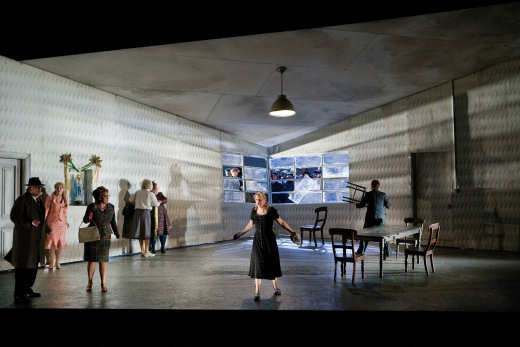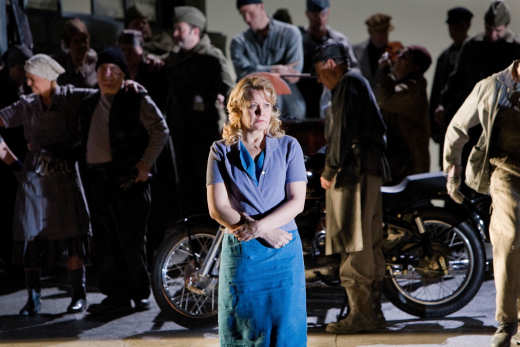Other Links
Editorial Board
-
Editor - Bill Kenny
-
Deputy Editor - Bob Briggs
Founder - Len Mullenger
Google Site Search
SEEN AND HEARD
UK OPERA REVIEW
Janáček,
Jenůfa:
Soloists, Chorus and Orchestra of English National Opera/Eivind
Gullberg Jensen. London Coliseum, 12.3. 2009 (CC)
This is a very welcome return for David
Alden’s double Olivier Award winning prodution of Jenůfa.
Alden’s
Lucia di Lammermoor was a stunningly intelligent
interpretation, and his Jenůfa similarly displays his
talents. Act I’s Buryja Mill is steely gray and resolutely
industrial. The lighting (consistently excellent throughout) only
served to underscore the oppressive scene, as did Janáček’s
obsessive repetition of melodic cells – later, it was a change in
lighting that identified beyond any doubt the moment of resolve that
the Kostelnička undergoes in Act II and will indeed take the baby’s
life. Much of the stage is bare much of the time, with large spaces
left between the characters, a technique that emphasises the
essential loneliness and hopelessness of the dramatis personae. The
Escher-like angles of the second act point to a distorted reality
while simultaneously implying a stultifying claustrophobia.
Susan Gorton makes an imposing Grandmother – the initial impression
is that this is so much so that Kostelnička could not possibly match
her. But in that role in fact, the American mezzo Michaela Martens, a singer most
associated with New York’s Met, more than lives up to the
expectations of the part as fearsome matriarch. Martens was
steely-voiced and determined. Only when she spoke rather than sang
(“I hope you enjoy yourselves here”) did her Stateside accent become
apparent. Her vital contributions to Act II revealed a character
tormented by shame. The lighting cast long shadows here, as if to
reflect the long shadows our actions cast. It is here that Kostelnička truly comes into her own, and in fact Mertens succeeded
so well that it was impossible for her Laca, Robert Brubaker, to
match her, dramatically or musically. Indeed, Brubaker confirmed
beyond a shadow of a doubt in Act III that despite a very good
voice, his acting ability tends towards zero. False and stiff, he
was uncomfortable to watch. Martens’ extended Act III confession was
gripping.

Amanda Roocroft was the titular heroine in the original production,
and returns here to deliver a searingly moving portrayal. She seems
to have a special affinity with the music of Janáček, for she also
impressed in the role of Mila in Osud in the 2008 Proms.
Despite a strong overall cast, she remains the clear star.
Technically, she has all of the requisite equipment with more to
spare and always with plenty in reserve while dramatically she
tracks the journey from feisty girl through to a character of
impeccable dignity forged by a sequence of soul-shredding disasters.
Her depiction of her co-dependency on Števa and her facilitating of
his addiction is harrowing to watch. It is impossible to pinpoint
Roocroft’s finest moment. Perhaps the Act II confrontation with
Kostelnička, or the prayer to the Virgin Mary, where the orchestra
miraculously mirrored the singer’s tenderness?

Amanda Roocroft as Jenůfa
Tom Randle was a macho Števa (sporting a fully functional motorcycle
in Act I). He has plenty of stage presence and swagger, and his
voice fully supports his characterisation. Iain Paterson, a
bass-baritone with a voice that sounds as if he is a bass pure and
simple, projected superbly.
The smaller roles are generally well taken. Peter Kestner, as the
Mayor, is a good second-league singer; Susanna Tudor-Thomas, as his
wife and dressed in an horrific green and red tartan creation, was
similarly more than acceptable.
On disc, the Mackerras English version on Chandos remains a firm
recommendation (I reviewed it here on MusicWeb in
May 2004). It is a
tribute to young Eivind Gullberg Jensen, making his UK operatic
debut here with ENO, that he hardly suffered at all in comparison.
The orchestra clearly likes Jensen, for the members play their
hearts out for him. Special mention should go to leader Janice
Graham’s wonderfully projected solos, perhaps. Jensen brought out
the folkish elements where appropriate (the Act I song about Nové
Zámky, a town now designated as being in Southern Slovakia, for
example), with a real feeling of unbuttoned abandon; similarly, in
the more festive parts of the last act, replete with traditional
Czech costumes on stage.
This is a limited run. There are only four performances of Jenůfa
left at the time of writing, so best to book soon. There were
precious few empty seats at the Coliseum for the present
performance.
Pictures © Robert Workman
Back
to Top
Cumulative Index Page
